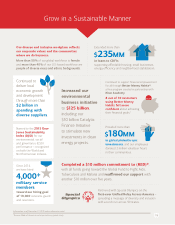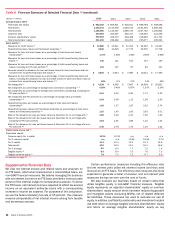Bank of America 2015 Annual Report Download - page 22
Download and view the complete annual report
Please find page 22 of the 2015 Bank of America annual report below. You can navigate through the pages in the report by either clicking on the pages listed below, or by using the keyword search tool below to find specific information within the annual report.20 Bank of America 2015
Executive Summary
Business Overview
The Corporation is a Delaware corporation, a bank holding company
(BHC) and a financial holding company. When used in this report,
“the Corporation” may refer to Bank of America Corporation
individually, Bank of America Corporation and its subsidiaries, or
certain of Bank of America Corporation’s subsidiaries or affiliates.
Our principal executive offices are located in Charlotte, North
Carolina. Through our banking and various nonbank subsidiaries
throughout the U.S. and in international markets, we provide a
diversified range of banking and nonbank financial services and
products through five business segments: Consumer Banking,
Global Wealth & Investment Management (GWIM), Global Banking,
Global Markets and Legacy Assets & Servicing (LAS), with the
remaining operations recorded in All Other. We operate our banking
activities primarily under the Bank of America, National Association
(Bank of America, N.A. or BANA) charter. At December 31, 2015,
the Corporation had approximately $2.1 trillion in assets and
approximately 213,000 full-time equivalent employees.
As of December 31, 2015, we operated in all 50 states, the
District of Columbia, the U.S. Virgin Islands, Puerto Rico and more
than 35 countries. Our retail banking footprint covers
approximately 80 percent of the U.S. population, and we serve
approximately 47 million consumer and small business
relationships with approximately 4,700 retail financial centers,
approximately 16,000 ATMs, nationwide call centers, and leading
online and mobile banking platforms (www.bankofamerica.com).
We offer industry-leading support to approximately three million
small business owners. Our wealth management businesses, with
client balances of nearly $2.5 trillion, provide tailored solutions to
meet client needs through a full set of investment management,
brokerage, banking, trust and retirement products. We are a global
leader in corporate and investment banking and trading across a
broad range of asset classes serving corporations, governments,
institutions and individuals around the world.
2015 Economic and Business Environment
In the U.S., the economy grew in 2015 for the seventh consecutive
year. Following a soft start to the year partly reflecting severe winter
weather and other temporary factors, economic growth picked up
mid-year before a mild deceleration near year end. While economic
growth struggled to reach two percent in the year, the labor market
continued to improve. Payroll gains were solid, while the
unemployment rate fell to five percent late in the year. With steady
employment gains and continued low oil prices, consumer
spending increased at a strong pace for most of the year and
residential construction gained momentum. Core inflation (which
excludes certain items which may be subject to frequent volatile
price changes, like food and energy) remained relatively unchanged
in 2015, more than half a percentage point below the Board of
Governors of the Federal Reserve System’s (Federal Reserve)
longer-term target of two percent. Inflation was suppressed by
falling energy costs.
U.S. household net worth rose for a seventh consecutive year,
but at a slower pace in 2015. After a modest first half of the year,
home prices rebounded in the second half of 2015 and rose more
than five percent in 2015, while equity markets registered little
net change. With energy costs continuing to decline in 2015, the
consumer spending outlook remained positive, although the
negative impacts on energy-related investments hurt the
manufacturing economy and continued to impact financial
markets. With the sharp U.S. Dollar appreciation in late 2014 and
2015, export gains slowed, further weakening manufacturing,
while import growth was steady, resulting in a decline in net exports
and a negative impact on 2015 gross domestic product growth.
U.S. Treasury yields were unstable, but rose modestly over the
course of the year, as a rate hike from the Federal Reserve neared.
At its final meeting of the year, the Federal Open Market Committee
(FOMC) raised its target range for the Federal funds rate by 25
basis points (bps), its first rate increase in over nine years. At the
same time, the Federal Reserve repeated its expectation that
policy would be normalized gradually, and would remain
accommodative for the foreseeable future. Amid the contrast
between U.S. tightening of monetary policy versus the easing of
monetary policy in much of the world, the U.S. Dollar appreciated
significantly over the year, especially against emerging market and
commodity-oriented currencies.
Internationally, the eurozone continued to grow modestly in
2015, as the European Central Bank (ECB) began a program of
significant purchases of sovereign debt, helping to keep bond
yields low and to maintain stability in southern European markets.
Core inflation in the eurozone stabilized early and then edged
higher over the year. The Euro/U.S. Dollar exchange rate continued
to decline early in the year driven by the differing directions of U.S.
and eurozone monetary policies, further boosting European
competitiveness. However, the eurozone remains vulnerable to
economic slowing in emerging markets. Late in the year, the ECB
extended its horizon for bond purchases, but failed to increase
their size.
Economic growth was slow and uncertain in Japan, while the
2014 gains in core inflation were reversed. Declining energy costs
continued to hurt Russia’s economy, which remained in recession
for 2015. Brazil’s recession also continued, aggravated by extreme
policy uncertainty. Amid continued gradual economic moderation,
China eased monetary policy during the year, but continued its
focus on longer-run issues including increasing its focus on
rebalancing the economy and encouraging consumer spending.
Recent Events
Settlement with Bank of New York Mellon
The final conditions of the settlement with the Bank of New York
Mellon (BNY Mellon) have been satisfied and, accordingly, the
Corporation made the settlement payment of $8.5 billion in
February 2016. The settlement payment was previously fully
reserved. Pursuant to the settlement agreement, allocation and
distribution of the $8.5 billion settlement payment is the
responsibility of the residential mortgage-backed securities
(RMBS) trustee, BNY Mellon. On February 5, 2016, BNY Mellon
filed an Article 77 proceeding in the New York County Supreme
Court asking the court for instruction with respect to certain issues
concerning the distribution of each trust’s allocable share of the
settlement payment and asking that the settlement payment be
ordered to be held in escrow pending the outcome of this Article
77 proceeding. The Corporation is not a party to this proceeding.
For additional information, see Off-Balance Sheet Arrangements
and Contractual Obligations on page 44.
























